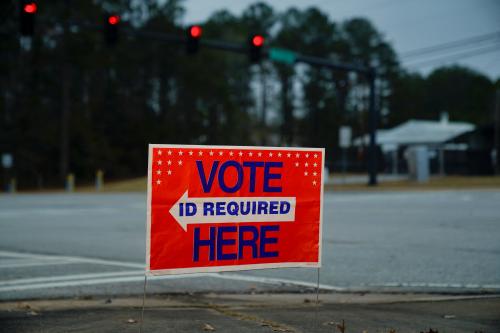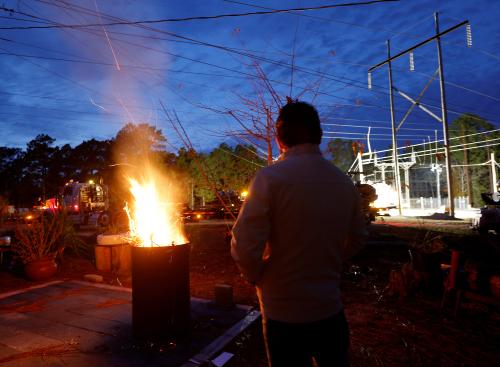The Bush administration is increasingly losing its clear voice and clear sense of direction on the subject of homeland security. Much more than politics is at stake. The lives of Americans are potentially at risk, and the administration needs to do a better job of protecting them.
Over the course of the last few days, senior administration officials have gone public with various kinds of warnings about a possible future terrorist attack. Last Sunday, Americans awoke to news reports that there was increasing “chatter” about an impending attack in the United States of even greater scope than the Sept. 11 attacks.
Then, Vice President Dick Cheney and National Security Adviser Condoleezza Rice amplified the warning on all the Sunday talk shows. Cheney warned that terrorists were “almost certain” to strike America again, but he couldn’t tell us whether this would be “tomorrow or next week or next year.” Missing was any hard information of when, how or where terrorists might strike.
Next to make newspaper headlines was FBI Director Robert Mueller, who indicated that it was “inevitable” that Mideast-style suicide bombers would strike on American soil. The following day, a senior official acknowledged that Mueller’s warning was not based on any specific piece of information, but only a logical conjecture on the FBI director’s part.
Tuesday saw three separate alerts. Homeland Security Director Tom Ridge warned that “we need to understand that it is not a question of if, but a question of when” terrorists will strike again. Defense Secretary Donald Rumsfeld asserted that terrorists “inevitably” will acquire, and use, chemical, biological or nuclear weapons. And the FBI sent word to New York of a possible attack against landmarks. One of them, the Brooklyn Bridge, was closed for an hour early yesterday so police could investigate a suspicious bag.
What is going on here? The rapid-fire issuing of warnings about possible attacks predictably has led the evening news and dominated the front pages of the nation’s newspapers.
But most are not very helpful. The warnings do not give citizens and officials any sense of how they should protect themselves against possible future attacks. Analytically, the warnings also can be challenged on the grounds that we do not know enough about what terrorists are planning to claim certain or near-certain knowledge about anything they might do next.
In fact, in important ways many of these warnings are worse than useless, since they stoke fears among Americans in a somewhat hyperbolic way. And the timing of the statements—coming on the heels of last week’s disclosures about what the Bush administration might have known before Sept. 11—even makes the administration vulnerable to the charge that it is playing politics with its use of terrorist warnings.
They certainly have changed the subject—and they can always be pointed to if an attack does in fact take place. Most problematic of all is that the loose talk devalues possible future warnings that might be more useful. Such warnings might include details that make preventive action possible. For example, in April, Attorney General John Ashcroft warned about possible attacks against banks in the Northeast, allowing these institutions to take extra precautionary steps. Earlier this month, U.S. officials informed law enforcement agencies about a possible threat to high-rise apartment buildings, thinking that terrorists might rent an apartment, gradually pack it with explosives, and then detonate it in an effort to destroy the building.
Just last week, and again on Sunday, Homeland Security Director Tom Ridge asked those living in high-rise buildings to keep their eyes open and report any suspicious activity to authorities. And Tuesday’s FBI warning of a threat to New York City landmarks allowed the police to beef up protection of those sites.
But are the most recent specific alerts being lost in the cacophony of administration alerts? Major newspapers reported what Cheney, Rice and Mueller had said, but not a word about the more specific threat Ridge had spoken about. Vague musings attracted the press. Specific warnings, with proposals for how to counter the threat, went largely unheard.
The administration may try to blame the media for this problem. But it is entirely its own fault. Given numerous platforms for discussing terrorism in recent days, top officials used them to provide assessments that were largely unhelpful. This underscores the need for two remedial steps.
First, the administration should start speaking with a single voice on the issue of future terrorist attack. That voice should be Ridge’s. He is in the best position to issue warnings. Other officials—whether it is the vice president, FBI director, or attorney general—should defer to Ridge on these matters and back him up or keep silent.
Second, the administration needs to be more careful and more coherent in how it alerts the nation. General warnings are not useful. What the American people need is warnings with sufficient information to give them a clear sense of how best to respond. The moment to get on with this is now. We may not have much time to lose.


![U.S. Secretary of State Colin Powell holds up a vial that he described as one that could contain anthrax, during his presentation on [Iraq] to the U.N. Security Council, in New York February 5, 2003. [Powell tried to persuade a sceptical world that Iraq is concealing it's weapons of mass destruction and that force may be necessary to disarm it.]](https://www.brookings.edu/wp-content/uploads/2022/12/2003-02-05T120000Z_553139269_PBEAHUORSAU_RTRMADP_3_POWELL.jpg?quality=75&w=500)
Commentary
Op-edLet’s Cool Those Terrorism Alerts
May 23, 2002